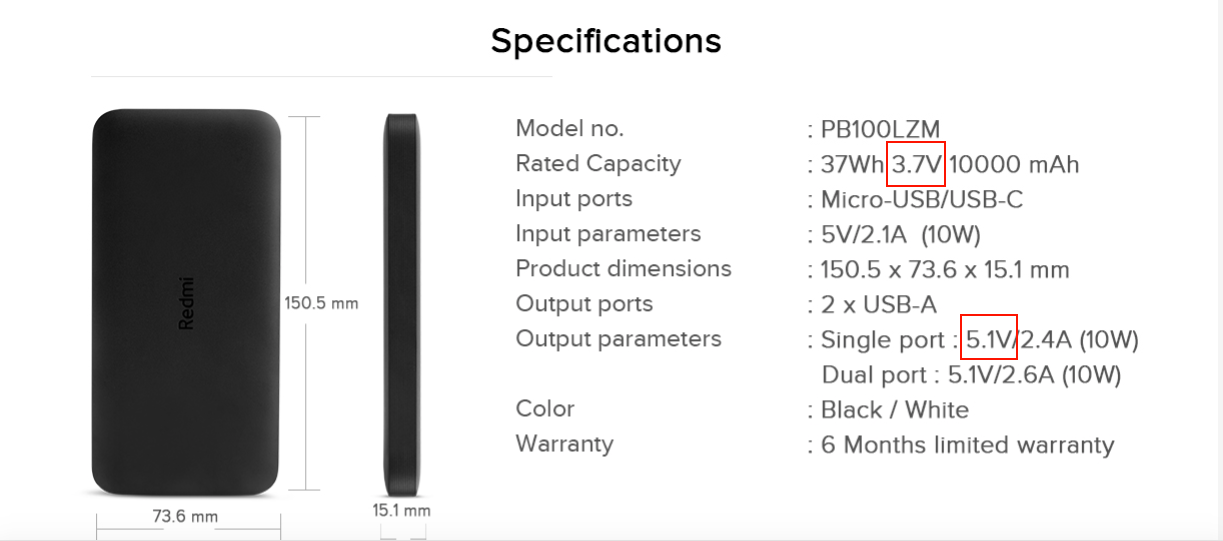What is the actual capacity of a power bank?

I recently posted an article on electronic gadgets that I carry in my backpack. In the article, I recommended that trekkers carry a high capacity power bank on the trail. Since that day I’ve had many emails from readers with tales on how their power bank has failed on the trail and which brand would I recommend? So if you intend to carry a power bank when out trekking – this article is for you!
“I have a 10,000mAh power bank. So it should charge my 3,300mAh phone battery thrice.
Right? Wrong!”
The Short Answer
All power bank manufacturers fudge. The actual capacity of a power bank is not the same as its advertised capacity. A quick rule of thumb is to assume that the actual capacity of a power bank is 70% of the advertised capacity. Thus the “actual capacity” of a 10,000mAh power bank is only around 7,000mAh
The Long Answer
- USB draws power at 5V (it is a part of the USB standard.2. Most batteries used in a power bank are 3.7V.
- The power bank’s “Advertised Capacity” is stated using these 3.7V batteries. Therefore if my power bank has 4 (four) 3.7V 2,500mAh batteries. Then 4 x 2,500mAh = 10,000mAh.
- However, since the power drawn via USB is 5V. Thus the “Actual Capacity” of a power bank is Actual Capacity = 3.7 x Advertised Capacity / 5. Thus for a 10,000mAh power bank (3.7 x 10000 / 5 = 7,400mAh)
- Then there is “Conversion Rate” - The power bank circuitry that converts the 3.7 V into 5 V USB is not 100% efficient. There are transmission losses, resistance and losses due to heat generation. Companies like Xiaomi (Mi India) mention this conversion rate on their website. 93% in Xiaomi’s case is pretty decent. Some power banks with cheap circuitry have conversion rate as low as 80%.

Therefore for a Xiaomi 10,000 mAh power bank, the “Actual Output Capacity” will be 3.7 x 10000 / 5 = 7,400 mAh and 7400 x 0.93 = 6,882mAh (68.8%). Using the same formula, Xiaomi’s 20,000 mAh power bank’s actual output capacity will be 13,764 mAh
Just under 70% as our rule of thumb states.
Warm stays Long
Most power banks are made with Lithium-Polymer (LiPo) batteries and the thing is that LiPo just doesn’t like cold temperatures.
As we can see, Li-Ion Polymer batteries have the best discharge capacity at around 20°-30° C, the capacity starts to drop off at a slower rate from 20° down to just below -1° C and drops off more rapidly from there. This means that the lower the temperature, the less power the battery can provide.
So why is this? Well, it turns out that Li-Ion polymer batteries are quite dry, and need heat to promote ion flow, so more heat = better ion flow. Less heat = higher internal resistance
Maximising Powerbank Capacity
To extract maximum power from your power bank follow the following tips-
- Use Good Quality Power Banks - Quality power banks have a higher efficiency (high conversion rate) of up to 95% due to optimised circuits.
- Use Quality Short Cables - Quality short cables have lower resistance and hence lead to less loss of power.
- Use 1.A Regular USB port - Charging with 1.0 Amp regular port will ensure greater efficiency than charging at fast-charging high current 2A or 2.4A USB ports.
- Keep the Power bank out of the Cold - Keep it in the inside pocket of your jacket during the day and inside your sleeping bag at night. Don’t leave it outside exposed to the elements
The performance of all batteries drops drastically at low temperatures; however, the elevated internal resistance will cause some warming effect because of efficiency loss during use. At –20°C (–4°F) most batteries stop functioning. Although NiCd can go down to –40°C (–40°F), the permissible discharge is only 0.2C (5-hour rate). Specialty Li-ion can operate to a temperature of –40°C but only at a reduced discharge rate; charging at this temperature is out of the question.
My Recommended Power Bank
I recommend 20,000 mAh Mi Power Bank for these reasons-
- I have been using one for over two years now and it has performed flawlessly.
- Xiaomi is honest enough to mention “conversion loss” and “actual output capacity” figures on their product page.
- The same capacity (albeit more advanced) power bank by a reputed company like Anker costs 3 times as much.
- The pro version has a higher conversion rate (93%) than their Made In India “I” brethren which are rated at 85%


